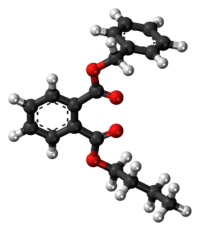Benzyl butyl phthalate
 | |
 | |
| Names | |
|---|---|
| Preferred IUPAC name
Benzyl butyl benzene-1,2-dicarboxylate | |
| Other names
Benzyl butyl phthalate | |
| Identifiers | |
| 85-68-7 | |
| 3D model (Jmol) | Interactive image |
| ChemSpider | 2257 |
| ECHA InfoCard | 100.001.475 |
| KEGG | C14211 |
| |
| |
| Properties | |
| C19H20O4 | |
| Molar mass | 312.37 g·mol−1 |
| Density | 1.1 g cm−3 |
| Melting point | −35 °C (−31 °F; 238 K) |
| Boiling point | 370 °C (698 °F; 643 K) |
| Except where otherwise noted, data are given for materials in their standard state (at 25 °C [77 °F], 100 kPa). | |
| | |
| Infobox references | |
Benzylbutylphthalate (BBzP), also called n-butyl benzyl phthalate (BBP) or benzyl butyl phthalate, is a phthalate, an ester of phthalic acid, benzyl alcohol and n-butanol. It comes under trade names e.g. Palatinol BB, Unimoll BB, Sicol 160, or Santicizer 160. It is mostly used as a plasticizer for PVC. It is considered a toxicant.
BBzP is commonly used as a plasticizer for vinyl foams, which are often used as floor tiles. Other uses are in traffic cones, food conveyor belts, and artificial leather.
BBP is classified as toxic by the European Chemical Bureau (ECB) and hence its use in Europe has declined rapidly in the last decade. There are only two producers remaining in the EU.
In 2008 four sellers of BBP were sanctioned by the Belgian Competition Council for participating in a cartel.[1][2]
Health effects
Canadian Authorities have restricted the usage of phthalates, including BBP, in soft vinyl children's toys and child care articles.[3]
A 2012 study conducted in New York City found that eczema was 52 percent more likely in children whose mothers had been exposed to higher concentrations of butylbenzyl phthalate, compared with those whose mothers had been exposed to lower concentrations. Exposure was measured through urine testing during the third trimester of pregnancy. All but one of the women in the study showed some level of exposure to butylbenzyl phthalate.[4]
BBP was listed as a developmental toxicant under California's Proposition 65 on December 2, 2005.[5] California's Office of Environmental Health Hazard Assessment (OEHHA), on July 1, 2013, approved a Maximum Allowable Dose Level of 1,200 micrograms per day for BBP.[6]
References
- ↑ Press release Council 04 04 08 Archived October 1, 2011, at the Wayback Machine.
- ↑ http://economie.fgov.be/organization_market/competition/press_releases/press_release_04042008_en.pdf
- ↑ Canada Gazette - Phthalates Regulations
- ↑ http://pubs.acs.org/action/showStoryContent?doi=10.1021%2Fon.2008.11.12.154968&
- ↑ http://prop65news.com/StoryDetails/tabid/101/ArticleID/6599/OEHHA-Adds-Three-Phthalates-as-Reproductive-Toxicants-to-Prop-65-List.aspx
- ↑ http://prop65news.com/StoryDetails/tabid/101/ArticleID/7502/OEHHA-Adopts-BBP-MADL.aspx
External links
- C-307 An Act respecting bis(2-ethylhexyl)phthalate, benzyl butyl phthalate and dibutyl phthalate
- Datasheet